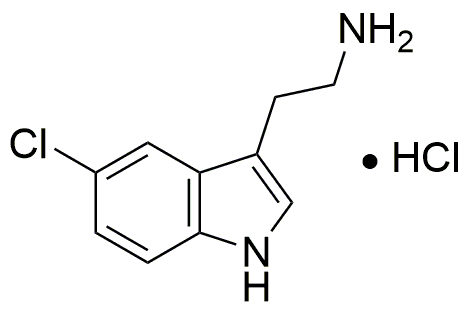5-Chlorotryptamine hydrochloride is widely utilized in research focused on:
- Neuroscience Research: This compound serves as a valuable tool for studying serotonin receptors, helping researchers understand mood disorders and potential treatments.
- Pharmaceutical Development: It plays a crucial role in the synthesis of new drugs targeting various neurological conditions, offering pathways to innovative therapies.
- Biochemical Assays: Used in assays to measure the activity of enzymes related to serotonin metabolism, aiding in the assessment of metabolic disorders.
- Psychopharmacology Studies: Researchers utilize it to investigate the effects of serotonin analogs on behavior, contributing to the understanding of psychoactive substances.
- Plant Biology: This compound can be applied in studies examining plant responses to stress, providing insights into plant biochemistry and resilience mechanisms.
General Information
Properties
Safety and Regulations
Applications
5-Chlorotryptamine hydrochloride is widely utilized in research focused on:
- Neuroscience Research: This compound serves as a valuable tool for studying serotonin receptors, helping researchers understand mood disorders and potential treatments.
- Pharmaceutical Development: It plays a crucial role in the synthesis of new drugs targeting various neurological conditions, offering pathways to innovative therapies.
- Biochemical Assays: Used in assays to measure the activity of enzymes related to serotonin metabolism, aiding in the assessment of metabolic disorders.
- Psychopharmacology Studies: Researchers utilize it to investigate the effects of serotonin analogs on behavior, contributing to the understanding of psychoactive substances.
- Plant Biology: This compound can be applied in studies examining plant responses to stress, providing insights into plant biochemistry and resilience mechanisms.
Documents
Safety Data Sheets (SDS)
The SDS provides comprehensive safety information on handling, storage, and disposal of the product.
Product Specification (PS)
The PS provides a comprehensive breakdown of the product’s properties, including chemical composition, physical state, purity, and storage requirements. It also details acceptable quality ranges and the product's intended applications.
Certificates of Analysis (COA)
Search for Certificates of Analysis (COA) by entering the products Lot Number. Lot and Batch Numbers can be found on a product’s label following the words ‘Lot’ or ‘Batch’.
Numéro de catalogue
Numéro de lot/série
Certificates Of Origin (COO)
This COO confirms the country where the product was manufactured, and also details the materials and components used in it and whether it is derived from natural, synthetic, or other specific sources. This certificate may be required for customs, trade, and regulatory compliance.
Numéro de catalogue
Numéro de lot/série
Safety Data Sheets (SDS)
The SDS provides comprehensive safety information on handling, storage, and disposal of the product.
DownloadProduct Specification (PS)
The PS provides a comprehensive breakdown of the product’s properties, including chemical composition, physical state, purity, and storage requirements. It also details acceptable quality ranges and the product's intended applications.
DownloadCertificates of Analysis (COA)
Search for Certificates of Analysis (COA) by entering the products Lot Number. Lot and Batch Numbers can be found on a product’s label following the words ‘Lot’ or ‘Batch’.
Numéro de catalogue
Numéro de lot/série
Certificates Of Origin (COO)
This COO confirms the country where the product was manufactured, and also details the materials and components used in it and whether it is derived from natural, synthetic, or other specific sources. This certificate may be required for customs, trade, and regulatory compliance.


